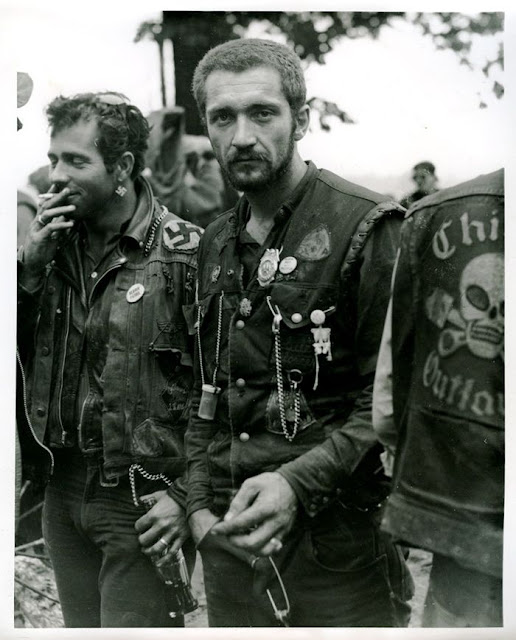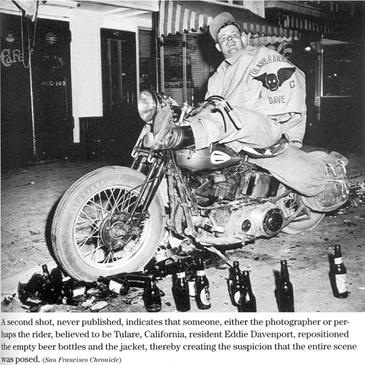The purpose of this web site is to inform the public of some of the time-forgotten biker ways. One example is; there is a wide belief that the only way females fit into motorcycle clubs is as a "piece of club property", truth is at one time the Hells Angels Motorcycle Club and other clubs had female 1% members.
You can search the internet, read books and watch movies and you will see many different Motorcycle Club beliefs and traditions. The motorcycle club is a true sub-culture of society, who live by their own set of rules.
There are many long-time standing traditions just as there are many time forgotten traditions in motorcycle history. Some of that history has been either forgotten or changed through the years to best serve a group looking to change history to fit that group. Sometime the history is lost in time or died out when the members moved away or died.
Just as other things in time changes and evolves so did the motorcycle club community.
Early 1900's - Motorcycles were used for transportation and recreation, out of that came motorcycle clubs and social riding groups for fun and for racing.
1910-1947 - Motorcycle racing grew with the help of A.M.A. and along with that motorcycle clubs grew. The Hollister event brought the biker sub-culture from the back page to the front page when the event "Riot" was published in Times Magazine.
1947-1965 - Motorcycle clubs started to evolve from racing clubs to street clubs and with that came a split bigger between A.M.A. clubs and "Outlaw" clubs.
1965-1975 - The Hells Angels were key in starting to reorganize and make uniform both the "colors" and the protocols of motorcycle clubs of today.
1975-Present - Motorcycle clubs are run a certain way today, much different then the ways of yesteryear. There are many protocols clubs are expected to abide by or be sanctioned.
The following is an informational motorcycle club related website; www.rcvsmc.net while this website does have a lot of good information for the inexperienced, but doesn't cover early motorcycle club history about how it started. Knowing how things got its start will help you understand why things are the way they are.
The public perception of "bikers" is as Hollywood has portrayed them in movies, as bad boys, rough tough dirty drunken brawling nomads. This perception has been in the general public minds for 50 years. In the past 30 years, many law abiding motorcycle clubs have formed across the country, which are involved in many charity causes, unfortunately that "biker" image is still there. The "biker" stigma is so strong that the law abiding clubs are accused of "emulating" the outlaw clubs. The truth is the outlaw clubs are emulating the early clubs of pre-WWII.
Wednesday, November 4, 2015
Tuesday, November 3, 2015
When did MOTORCYCLE CLUBS really get their start
If you ask the question; "When did motorcycle clubs get their start ?" you will likely get overwhelmed with answers, but most people will say with motorcycle clubs like the Hells Angels sometime after WWII or after the Biker Riot in Hollister in 1947.
The truth is; motorcycle clubs have been around as long as there has been a motorcycle to ride.
As early as the 1900's motorcycle clubs were forming. The Portsmouth Motorcycle Club claims to be the first Motorcycle Club in the United States forming in 1893 as the Portsmouth Cycling Club.
These very early Motorcycle Clubs rode European motorcycles, due to Harley Davidson and Indian motorcycles not being made at that time.
As most of these motorcycle clubs were formed they become involved in motorcycle racing of one type or another. As the Motorcycle Clubs formed, organizations also formed to unite the motorcyclists. Two groups formed to unite, organize races and events, from 1903 to 1919 it was the FAM-Federation of American Motorcyclists and from 1923 to Present it is the AMA-American Motorcyclist Association.
Ironically it was the AMA Gypsy Tour of July 4th weekend 1947 in Hollister Califormia which led to the infamous Hollister Biker Riot. The Hollister incident started the outlaw biker image of today.
Just like with today's motorcycle racing each teams, each group had a different name on their jerseys, shirts or jackets. Each club also had a different team color combination, the purpose was so they can be quickly seen during the race, just as it's done today.
Generally, before WWII motorcycle clubs only had their club names on their jerseys. Their names were generally the area or city they were from. After WWII the same clubs started to transform their club name into a club patch with their clubs names incorporated into the patch design. Some even incorporated their individual race number into their patch.
 |
| Cal-Poly Penguins M.C. (mid 1940's) Patch transformation; Right-club letters only Left-club patch only |
 |
| 1940's Racing Jersey #6 |
 |
| 1940's Motorcycle Club patch with matching number from Racing Jersey above |
The following is one example of an early motorcycle club raising a little hell back in the day; the Kansas City Journal newspaper reported that on February 26, 1908, 19 members of the Kansas City Motorcycle Club were out on a ride. As they passed a local farmer the motorcycle groups loud exhaust noise caused his horse to buck and his family members to be thrown to the ground and hurt. The farmer sued the motorcycle club due to their reckless behavior and requested compensation for his family’s injuries. A few months later a Jackson County Missouri Judge dismissed the lawsuit. One of the motorcycle club members was a man named O.J. Plummer, who stated to build motorcycles around 1898 in Kansas City. Oscar J. Plummer's motorcycle is on display in the Kansas City Missouri Museum.
 |
| O.J. Plummer Motorcycle K.C.M.O. |
 |
| O.J. Plummer's Motorcycle K.C.M.O. |
 |
| The front cover of the magzine for the below listed photo |
 |
| 1908 Magazine lists very early Motorcycle Clubs |
Monday, November 2, 2015
What is the true meaning of the term OMG "OUTLAW MOTORCYCLE CLUB"
The term "Outlaw Biker"or "Outlaw" as it refers to the motorcycle community first came about back in the late 20's and early 30's. The "A.M.A." (American Motorcyclist Association) (1924 to present) replaced the "F.A.M." (Federation of American Motorcyclists) (1903-1919). Throughout the early 1900's both groups were pushing for the organization of all motorcyclists and motorcycle clubs. Both FAM and AMA charged both membership and monthly dues, set rules for both conduct and organization and as a reward offered good cash payouts in its races. Due to several reasons, the depression being one, many riders and clubs resisted joining the AMA. The AMA responded by attempting to shame and discredit non AMA riders and clubs. AMA said those who didn't join were operating "Illegal" and were nothing but a bunch of "Outlaws" referring to their nonconforming position. When the term "Outlaw" was first used it never referred to a person or club being a involved in criminal activity. Comments made by a city officials after both the 1948 & 1949 Gypsy Tours on July 4th weekends in Hollister & Riverside, CA referred to all the troublemakers as "Outlaws". After both the Hollister and Riverside incidents the stage was set for the division between AMA and the "Outlaws". The AMA members had their rules to operate by and the "Outlaws" had theirs. AMA were about looking and acting respectful to everyone. AMA even awarded trophies to the best dressed club at AMA events. The "Outlaws" did the opposite, they looked and acted as obnoxious as they could, the worse the better, they would hold impromptu street races to raise a little hell.
Below is a photo of an arrest from Hollister 1947 which was made famous in Times Magazine. Also is the movie "The Wild One" starring Marlon Brando which was a Hollywood remake of the Hollister Biker Riot.
Their are a few of these original "Outlaw" clubs around today like the Market Street Commandos, Galloping Goose & Moonshiners to name a few.
These were the original "Outlaw" clubs, the forerunners for today's "Outlaw" clubs.
Below is a photo of an arrest from Hollister 1947 which was made famous in Times Magazine. Also is the movie "The Wild One" starring Marlon Brando which was a Hollywood remake of the Hollister Biker Riot.
Their are a few of these original "Outlaw" clubs around today like the Market Street Commandos, Galloping Goose & Moonshiners to name a few.
These were the original "Outlaw" clubs, the forerunners for today's "Outlaw" clubs.
 |
| A.M.A. Trophy awarded to an A.M.A. Motorcycle Club for A.M.A. events or dress |
 |
| An A.M.A. Motorcycle Club at an event awarded for their appearance |
 |
| Non A.M.A. Motorcycle Club don't care about their appearance |
 |
| An arrest at the Hollister CA 1947 "Biker Riot" |
 |
| 1947 Times Magazine report on the "Biker Riot" |
 |
| This photo shows that the above photo was a staged photo |
 |
| The movie based on the 1947 Hollister "Biker Riot" |
Sunday, November 1, 2015
What does a "DIAMOND 13" patch really mean
There is a lot of controversy and misunderstanding surrounding the "Diamond 13" patch. If you ask 10 different bikers what the patch means, you'll get 10 different answers. Some will say it stands for the thirteenth letter if the alphabet "M" which stands for motorcycle or marijuana. Some will say it means "only 12 Jurors and 1 Judge can judge me. Some 1% clubs use the patch in recognition and to identify their support clubs.
Ask yourself, why is the same patch so widely used and has all these different meanings? There has to be something more to the patch.
Lets look at the history of the patch. A friend of mine who was a member of one of these early "Outlaw" MC, relayed the following;
The "Diamond 13" patch got it's founding in Southern California in the early 30's as an anti-AMA patch. It was used by the early "Outlaw" clubs to show their separation from AMA clubs and to show their dissatisfaction with the AMA movement and rules. In the early 30's the AMA was trying to take over both the racing and motorcycle club scene and not everyone was happy about it. AMA was proud of their patch, so the anti-AMA movement, "The Outlaws", created their own movement without the strict AMA rules. Most AMA races paid out more and was very attractive for some racers and racing clubs.
The "13" on the patch stood for the Top 13 "Outlaw" motorcycle clubs in Southern California, the Top 13 outlaw racing clubs were awarded the patch and a trophy. After that they become part of the "Diamond Club" which was a small part of the Southern California Outlaw Federation racing scene. In the early 60's when the 1% movement came about, the 13 on the patch changed into a 1%. The diamond patch shape was used because it already stood for the anti-AMA movement and it was AMA who used the term 99% of bikers are law abiding.
 |
| 1939 S.C.O.F. Trophy awarded to the Moonshiners MC |
The "13" was widely used into the mid 1960's as an outlaw symbol. Below are Hells Angels MC members which show the transition from the "13" to the 1% Diamond. In the mid 1970's the 1% diamond become standard in the front of the MC colors. Some Motorcycle Clubs wore the 1%'er patch as a square shape before it was a diamond shape.
 |
| Hells Angels MC with a "13" patchs |
 |
| Hells Angels MC mid 1960's "13" patch |
 |
| Hells Angels M.C. |
 |
| Hells Angels M.C. 1965 |
Subscribe to:
Comments (Atom)







